When I first started learning about finance, I found myself overwhelmed by the jargon. One term that kept popping up was “spread.” At first, I thought it was just a simple difference between two numbers, but as I dug deeper, I realized it was much more nuanced. Spreads are everywhere in finance—from bonds and loans to trading and investing. Understanding spreads is crucial for anyone looking to make informed financial decisions. In this guide, I’ll break down the concept of spread, explain its various forms, and show you how it impacts the financial world.
Table of Contents
What Is a Spread?
At its core, a spread is the difference between two values. In finance, it often refers to the difference between two interest rates, prices, or yields. For example, if the interest rate on a loan is 5% and the risk-free rate is 2%, the spread is 3%. This simple concept, however, has far-reaching implications. Spreads are used to measure risk, profitability, and market conditions.
Let’s start with the basics. Suppose you’re comparing two bonds: Bond A yields 4%, and Bond B yields 6%. The spread between them is:
This 2% spread tells us that Bond B offers a higher return than Bond A. But why? Is it because Bond B is riskier? Or is it because of market conditions? To answer these questions, we need to explore the different types of spreads and their applications.
Types of Spreads
Spreads come in many forms, each serving a unique purpose. Below, I’ll discuss the most common types you’ll encounter in finance.
1. Bid-Ask Spread
The bid-ask spread is one of the most fundamental concepts in trading. It represents the difference between the highest price a buyer is willing to pay (bid) and the lowest price a seller is willing to accept (ask). For example, if a stock has a bid price of $50 and an ask price of $51, the bid-ask spread is:
This $1 spread is a cost to traders. The narrower the spread, the more liquid the market. High liquidity means you can buy or sell an asset quickly without significantly affecting its price.
2. Yield Spread
Yield spread is the difference between the yields of two bonds. It’s often used to compare the risk of different bonds. For instance, let’s compare a U.S. Treasury bond (considered risk-free) and a corporate bond. If the Treasury bond yields 3% and the corporate bond yields 5%, the yield spread is:
This 2% spread compensates investors for the additional risk of holding the corporate bond.
3. Credit Spread
Credit spread is a subset of yield spread. It specifically measures the difference in yield between a corporate bond and a government bond of the same maturity. A wider credit spread indicates higher perceived risk. For example, during an economic downturn, credit spreads often widen as investors demand higher compensation for risk.
4. Option-Adjusted Spread (OAS)
The option-adjusted spread is a more advanced concept. It measures the spread of a bond with embedded options (like callable bonds) relative to a risk-free bond. OAS accounts for the possibility that the bond’s cash flows may change due to the option. For example, if a callable bond has an OAS of 1.5%, it means the bond offers a 1.5% higher yield after adjusting for the option risk.
5. Z-Spread
The Z-spread, or zero-volatility spread, is the constant spread that makes the present value of a bond’s cash flows equal to its market price. It’s used to value bonds with irregular cash flows. For example, if a bond’s cash flows are discounted at the Treasury yield plus a 1.5% Z-spread, the bond’s price matches its market value.
Why Spreads Matter
Spreads are more than just numbers—they’re indicators of market health, risk, and opportunity. Here’s why they matter:
1. Measuring Risk
Spreads help investors assess risk. A wider spread typically indicates higher risk. For example, during the 2008 financial crisis, credit spreads widened dramatically as investors feared defaults.
2. Pricing Financial Instruments
Spreads are used to price bonds, loans, and derivatives. For instance, mortgage rates are often quoted as a spread over the 10-year Treasury yield.
3. Trading Strategies
Traders use spreads to identify arbitrage opportunities. For example, if the spread between two similar bonds is unusually wide, a trader might buy the cheaper bond and sell the more expensive one, betting the spread will narrow.
4. Economic Indicators
Spreads can signal economic trends. For example, a narrowing yield spread between short-term and long-term Treasury bonds (a flattening yield curve) may indicate an upcoming recession.
Examples and Calculations
Let’s dive deeper with some examples.
Example 1: Calculating Bid-Ask Spread
Suppose you’re trading a stock with the following prices:
- Bid: $100
- Ask: $101
The bid-ask spread is:
If you buy the stock and immediately sell it, you’ll lose $1 per share due to the spread.
Example 2: Yield Spread in Bonds
Consider two bonds:
- Bond X (Corporate Bond): Yield = 6%
- Bond Y (Treasury Bond): Yield = 4%
The yield spread is:
This 2% spread compensates investors for the additional risk of Bond X.
Example 3: Credit Spread During a Crisis
During the 2008 financial crisis, the credit spread between corporate bonds and Treasury bonds widened significantly. For example:
- Corporate Bond Yield: 10%
- Treasury Bond Yield: 3%
The credit spread is:
This 7% spread reflected the heightened risk of corporate defaults.
Spreads in Different Markets
Spreads play a vital role in various financial markets. Let’s explore a few.
1. Fixed Income Markets
In the bond market, spreads are used to compare the yields of different bonds. For example, municipal bonds often have lower yields than corporate bonds because they’re tax-exempt.
2. Foreign Exchange Markets
In forex trading, the spread is the difference between the bid and ask prices of a currency pair. For example, if the EUR/USD pair has a bid price of 1.1000 and an ask price of 1.1005, the spread is 0.0005 (or 5 pips).
3. Options Markets
In options trading, the spread refers to the difference between the strike prices of two options. For example, a bull call spread involves buying a call option with a lower strike price and selling one with a higher strike price.
Factors Affecting Spreads
Several factors influence spreads, including:
1. Market Liquidity
In liquid markets, spreads tend to be narrower because there are more buyers and sellers.
2. Credit Risk
Higher credit risk leads to wider spreads. For example, junk bonds have wider spreads than investment-grade bonds.
3. Economic Conditions
During economic uncertainty, spreads often widen as investors demand higher compensation for risk.
4. Interest Rates
Changes in interest rates can affect spreads. For example, rising interest rates may widen credit spreads as borrowing costs increase.
Spreads and Investment Strategies
Understanding spreads can help you develop better investment strategies. Here are a few examples:
1. Bond Laddering
By investing in bonds with different maturities, you can take advantage of yield spreads and reduce interest rate risk.
2. Pairs Trading
This strategy involves buying one security and selling another to profit from changes in the spread between them.
3. Credit Spread Options
These options allow you to profit from changes in credit spreads. For example, you might buy a credit spread option if you expect spreads to widen.
Conclusion
Spreads are a fundamental concept in finance, but they’re often misunderstood. By breaking down the different types of spreads and their applications, I hope I’ve made this topic more accessible. Whether you’re trading stocks, investing in bonds, or analyzing economic trends, understanding spreads can give you a significant edge.




